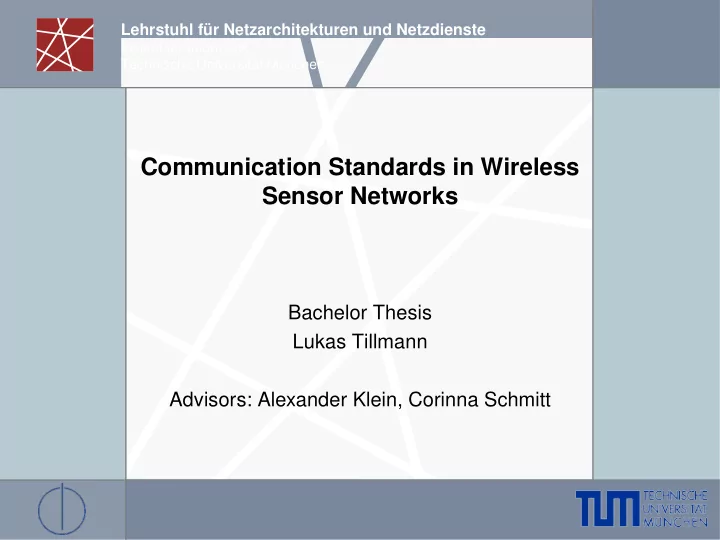

Lehrstuhl für Netzarchitekturen und Netzdienste Institut für Informatik Technische Universität München Communication Standards in Wireless Sensor Networks Bachelor Thesis Lukas Tillmann Advisors: Alexander Klein, Corinna Schmitt
Outline Definition of WSN Communication Standards Goals of this thesis Analysis technology and methods Evaluation Conclusion Communication Standards in Wireless Sensor Networks 2
Outline Definition of WSN Communication Standards Goals of this thesis Analysis technology and methods Evaluation Conclusion Communication Standards in Wireless Sensor Networks 3
Communication Standards - Overview There is no uniform protocol standard in Wireless Sensor Networks (WSNs) Independent development by different interest groups trying to meet similar challenges IEEE 802.15.4 Implementation of the Physical and Data Link Layers Specifically designed for use in Wireless Low-Power Networks (WPANs) Provides usage of different frequency ranges, CSMA and address ranges Maximum Transmission Unit (MTU) of 128 bytes ZigBee and 6LoWPAN - two IEEE 802.15.4 based Standards Communication Standards in Wireless Sensor Networks 4
Communication Standards - ZigBee ZigBee Holistic standards solution in WSNs Implements all Layers up to the Application Layer Provides mechanisms for network creation, maintenance, adressing, application interfaces, etc. Communication Standards in Wireless Sensor Networks 5
Communication Standards – 6LoWPAN 6LoWPAN (IPv6 over Low-Power Wireless Personal Area Network) Implementation of an Adaption Layer to enable the usage of IPv6 in WSNs Provides several mechanisms to shorten IPv6 frames Communication Standards in Wireless Sensor Networks 6
Goals of this thesis Presentation of ZigBee and 6LoWPAN regarding Functional principles Network creation Data transmission / shortening mechanisms Integrated security mechanisms Behavior in simulations Questions handled in this thesis What different approaches were taken? How it data transmission handled? How are the specific challenges in WSNs managed? How do these protocol standards behave in simulations? Communication Standards in Wireless Sensor Networks 7
Used Analysis Tool Simulating different scenarios using OPNET – ZigBee simulator 6LoWPAN not supported by OPNET simulation Reasons for using just one simulator/protocol standard: Very few noticeable differences between two similar standards. Problems comparing the results of two different simulators because of Different possiblities/limitations when it comes to data input Different ways of computing the statistics Communication Standards in Wireless Sensor Networks 8
Analysis Methods Used simulation topologies: Star, Chain, Grid Used simulation variations: Differing number of nodes active within a network Differing traffic intensity For each simulation run, one network model is used Nodes are present and signed in to the PAN at all times Differing start and stop times for application data transmission Communication Standards in Wireless Sensor Networks 9
Gathering the data Gathering the data Ten simulation runs with differing seed values are performed Merging and sorting the data by using a small Java program Communication Standards in Wireless Sensor Networks 10
Star topology All traffic is directed towards the Coordinator Nodes gradually join in on data transmission Communication Standards in Wireless Sensor Networks 11
Star topology Interarrival Time 5 seconds Packet size 64 bytes Overall delay respective to the number of nodes active in the network Communication Standards in Wireless Sensor Networks 12
Star topology Interarrival Time 1 second Packet size 128 bytes Overall delay respective to the number of nodes active in the network Increase in delay as more retransmission become necessary Decrease in variance as retransmission become the norm Communication Standards in Wireless Sensor Networks 13
Star topology Interarrival Time 1 second Packet size 128 bytes Percentage of packets dropped (maximum number of backoff retransmissions reached (4)) in a star topology high traffic variant Communication Standards in Wireless Sensor Networks 14
Chain topology All traffic is directed towards the Coordinator Increasing number of hops towards the destination Only one node sends at a time Communication Standards in Wireless Sensor Networks 15
Chain topology Interarrival Time 5 seconds Packet size 128 bytes Gradual and steady growth of End-to-End delay as number of hops increases (avg. 6.145 ms per additional hop) Increase in variance due to escalation from previous values Communication Standards in Wireless Sensor Networks 16
Grid topology All traffic is directed towards the Coordinator Nodes drift away from the center with 0.25 meters/minute Topology structure (parent-child associations) remains intact Start: 10 meters spacing between adjacent nodes End: 150 meters spacing between adjacent nodes Communication Standards in Wireless Sensor Networks 17
Grid topology Interarrival Time 2 seconds Packet size 64 bytes Packet loss ratio after maximum number of backoffs (4) is reached Decrease as node density is eased Communication Standards in Wireless Sensor Networks 18
Grid topology Interarrival Time 2 seconds Packet size 64 bytes Load in bits/s respective to the distance between two adjacenting nodes Load decreases as node density decreases due to fewer required retransmission attempts Communication Standards in Wireless Sensor Networks 19
Conclusion ZigBee All-in-One solution Provides interfaces in the Application Layer Best suited for secluded systems 6LoWPAN Built for adaption of IPv6 in WSNs Handles the parsing between IPv6 and 6LoWPAN headers No application support provided Best suited for traffic that exceeds the WSN Used protocol standard can be chosen according to the needs of a specific WSN! Communication Standards in Wireless Sensor Networks 20
Questions Thank you for your attention ! Communication Standards in Wireless Sensor Networks 21
OPNET Screenshot – Star Low Traffic „Time average“ Communication Standards in Wireless Sensor Networks 22
OPNET Screenshot – Star Low Traffic „As Is“ Communication Standards in Wireless Sensor Networks 23
Recommend
More recommend